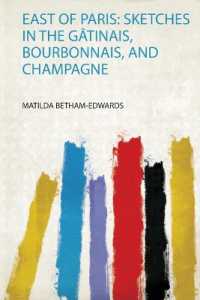Full Description
As an island-a geographical space with mutable and porous borders-Cuba has never been a fixed cultural, political, or geographical entity. Migration and exile have always informed the Cuban experience, and loss and displacement have figured as central preoccupations among Cuban artists and intellectuals. A major expression of this experience is the unconventional, multi-generational, itinerant, and ongoing art exhibit CAFÉ: The Journeys of Cuban Artists. In Cuban Artists Across the Diaspora, Andrea O'Reilly Herrera focuses on the CAFÉ project to explore Cuba's long and turbulent history of movement and rupture from the perspective of its visual arts and to meditate upon the manner in which one reconstitutes and reinvents the self in the context of diaspora.
Approaching the Cafeteros' art from a cultural studies perspective, O'Reilly Herrera examines how the history of Cuba informs their work and establishes their connections to past generations of Cuban artists. In interviews with more than thirty artists, including JosÉ Bedia, MarÍa Brito, Leandro Soto, Glexis Novoa, Baruj Salinas, and Ana Albertina Delgado, O'Reilly Herrera also raises critical questions regarding the many and sometimes paradoxical ways diasporic subjects self-affiliate or situate themselves in the narratives of scattering and displacement. She demonstrates how the Cafeteros' artmaking involves a process of re-rooting, absorption, translation, and synthesis that simultaneously conserves a series of identifiable Cuban cultural elements while re-inscribing and transforming them in new contexts.
An important contribution to both diasporic and transnational studies and discussions of contemporary Cuban art, Cuban Artists Across the Diaspora ultimately testifies to the fact that a long tradition of Cuban art is indeed flourishing outside the island.
Contents
Acknowledgments
"For the Cuban Dead," by Ricardo Pau-Llosa
CafÉ cubano À la Grisel
Introduction. Setting the Tent Against the House
Chapter One. Cuban Cultural Expression On and Off the Island: The Condition of "Unfreedom"
Oppositional Art in Cuba: Volumen Uno and the 1980s Generation
The Soviet Socialist Art Movement
PurÉ
Arte Calle
Cuban Art Outside the Island
Chapter Two. Repeating the Unrepeatable: CAFÉ and the Journeys of Cuban Artists
The Origins of CAFÉ
CAFÉ in a Postindustrial Age
Chapter Three. Mapmaking in Diaspora: A Crumb of Madeleine
CAFÉ: An Encounter with Newness
Chapter Four. CAFÉ and the Cuban Modernist Movement
The Cuban Vanguardia
The Influence of Europe in Cuban Visual Arts
The Creolization of Cuban Culture
JosÉ Bedia
Angela Valella
RaÚl Villarreal
Leandro Soto
De palo pa' rumba
JoaquÍn GonzÁlez
Rafael LÓpez Ramos
Laura Luna
Ana MarÍa Sarlat
Chapter Five. Seams of Continuity: The Landscape of the Dispossessed
Cuban Paisajismo
RaÚl Villarreal
Baruj Salinas
Ana Flores
Nelson GarcÍa Miranda
Ana Albertina Delgado
Rosario "Chary" Castro-MarÍn
Chapter Six. The Architecture of Longing and Remembrance
Natasha Perdomo
Anita Guerra
Dora HernÁndez
Armando Tejuca
Glexis Novoa
Chapter Seven. The Trope of Displacement, the Disruption of Space
Victor CaldÉe
Pedro VizcaÍno
JoaquÍn GonzÁlez
MarÍa Brito
Sergio GarcÍa
Adriano Buergo
Israel LeÓn Viera
Yovani Bauta
Elizabeth Cerejido
Pedro Portal
Jorge Arango
Gloria Lorenzo
Roberto Wong
Chapter Eight. Discourses of Positionality
The Fertile Nature of Dispersion and Rerooting
Cultural Identity in Transition
The Fifteenth Province
Epilogue. Cuba, a Work in Progress
Appendix A: Artists Included in CafÉ: The Journeys of Cuban Artists
Appendix B: "CafÉ con leche," by Antonia "ToÑi" Otaola Barco
Notes
List of Illustrations





